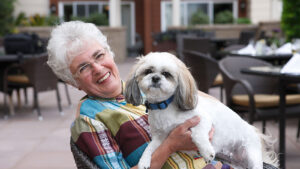Dementia is an umbrella term that describes a set of symptoms related to cognitive loss. It is not a disease itself. Alzheimer’s is the most common type of dementia. Dementia is a shift in the way a person experiences the world around her/him. By managing our own behavior, actions, words and reactions, we can change the outcome on an interaction. As caregivers, we need to respond, not react.
Being right/truthful doesn’t necessarily translate into successful results for both of you.
We must also change our approach and behavior to get the results we want. The focus needs to be on the relationship (big picture), not the individual encounter.
We use communication to interact with others and to get something done. There are five different forms of sensory connections used to communicate with people with dementia. In order to successfully communicate with someone with memory loss, a personal connection must be made before starting a conversation. Let the person connect with you visually. He or she needs to process that you are OK before you proceed with anything else. They understand you mean them no harm.
The next type is verbal communication. However, with dementia, the temporal lobe of the brain, the language center, is affected with word loss. In the early stages of Alzheimer’s, most word losses are nouns, names, and relationship references. Think about what this means. You have trouble understanding what the person is trying to say. The person with dementia has trouble understanding all of the words that you speak. Following instructions is difficult. Confabulation is when the brain makes up stuff to fill in the blanks of what they don’t remember.
Keep the following in mind:
- Specific words are hard to recall. Nouns are the first words lost.
- Descriptive abilities tend to become repetitive generalizations, “Nice”. Pat phrases can mislead a physical need, “No, thank you. I’m fine.”
- In the early phases of Alzheimer’s, ¼ of the words are lost (assuming good hearing). “I’ve lost my …”
- In the mid stages of the disease, ½ of the words are lost. Person relies on more familiar words. Cannot form full sentences.
- Comprehension is impaired when the person has loss of vocabulary.
- In the late stage, verbal use limited to one or two words. Expressions and gestures frequently used to communicate.
- Cursing language is stored separately from formal language in the brain.
- Rhythmic language helps with social language. Chit chat is more effective than formal language structure. Musical memories and words are retained.
- The third step in sensory communication is touch. Hold your hand out to place on their forearm or knee. The person with memory loss will feel the touch or movement and focus on you. This will get their attention. The communication link works because of the physical connection.
- Smell creates an emotional connection. The aroma of baked cookies is pleasant. However, people don’t recognize dangerous smells, such as gas or spoiled food.
- Taste is the last sensory connection. People with dementia like sweets and need to eat more of them to get their “sugar high”. Sour things actually taste better at this stage.
The Positive Interaction Approach to Someone with Dementia:
- Knock and announce yourself.
- Greet the person by name and smile.
- Move slowly. Offer your hand in the handshake position.
- Move from the front to the side, less confrontational.
- Greet with a handshake and your name. Keep holding the person’s hand.
- Get to the person’s eye level.
- Be friendly, offer a compliment or greeting. Put a smile in your voice.
- Give your message…simply, short, friendly.
- How you speak matters:
- Have a friendly tone in your voice.
- The deeper the pitch of your voice, the better it is heard.
- Speak slowly, not loudly. They are not deaf (in most cases).
- Make your message clear:
- Use short sentences that state what you want. “Please stay inside”.
- Be patient and don’t rush the person.
- Give directions one step at a time.
- Give the person time to process what you’ve said.
- Use the same words when you have to repeat a phrase.
- Use concrete words. “Put the cup on the table.”
- As dementia progresses, avoid open-ended questions. Use questions that require only a yes or no response.
- Limit choices.
- Provide sensory cues that will aid the person in understanding, such as a towel and soap for bath time.
- Avoid expressions you don’t want taken literally. “Hop into bed now.”
People with dementia always comprehend much more than they can express. Don’t say anything in front of them that you wouldn’t want them to understand. Respect their dignity. The emotional area of the brain is preserved. Feelings are very real. Our words won’t be heard until there is an emotional connection…that we have validated their emotion.
When you are having trouble being understood:
- Be patient. Allow enough time. Fran Lebowitz says that “the opposite of listening isn’t talking. The opposite of talking is waiting.”
- Demonstrate visually what you are saying.
- Say it more simply.
- Use alternate forms of communication (e.g. cueing, written words).
- Redirect with a hug, if appropriate, or change the subject.
When you are having trouble understanding:
- Listen to what the person is trying to say. Listen to their tone.
- Focus on a word or phrase that makes sense.
- Respond to the emotion of the statement.
- Stay calm and be patient.
How to deal with the person’s distress, anger or frustration:
- Try to figure out what the person really needs or wants. “It sounds like…” “You’re feeling…”
- Use empathy. Do not try and correct them or force them into your reality.
When the person is listening and responding to you, then redirect his attention and actions to something that is positive. Or distract him with other things or activities you know he likes (music, a stuffed animal, a snack).
If what you are doing is NOT working…STOP! Back off and give the person some time and space. When you re-approach, decide on what you will do differently. Then try again. We are the ones who can change the outcome of our interactions. By insisting that the person with memory loss does what we want when we want it is a formula for failure. It only increases agitation in the person and the caregiver.
Many behaviors of people with memory loss have logical explanations that reflect what is happening around them. These behaviors are the person’s attempts to cope and communicate their needs. Behavioral expressions are the symptom, not the problem!
Competency concerns will cause people with dementia to withdraw or refuse to participate. They may say they aren’t interested. Don’t force them to try.
When a person with Alzheimer’s disease and limited verbal skills has a problem, figuring out the cause can be challenging. What is the real reason for problem behaviors? The emotional needs of a person with dementia are influenced by their physical environment. You must play detective and look for environmental clues first.
- When, where did it occur? Is there a pattern?
- Was there too much stimuli?
- Who was present? Were they the cause?
- What happened immediately before?
- Fear, Confusion: Resistance to care?
After all of the environmental sources have been reviewed without a plausible answer, consider medical causes:
- Physical or emotional health problems?
- Pain, Discomfort: Is the person thirsty, hungry, or tired?
- UTI
- Medication issues: any change in medications?
- Frustration, Depression: difficulty with disease related changes
The manner in which we approach people with memory loss and provide care has profound effects upon their abilities and overall well-being. The world of the person with dementia changes as the disease progresses. We must also change our approach and response to adapt to their evolving needs.
Things to Remember:
- Do not argue with someone who has dementia. You cannot win. You increase their agitation and frustration.
- Never say “Don’t you remember…?”
- An Alzheimer’s brain is 1/3 the size of a normal brain. Remember that YOU are the one with the healthy brain.
- Resistive behavior is a coping mechanism (fear, confusion, discomfort).
- Do not use the word don’t.
- Keep the person with memory loss occupied or they will improvise and also time travel.
The ability to hear sound remains unless they are overwhelmed. Demented people think they can’t hear, but really they can’t comprehend.
While you base your conversation in logic and reason, the person with memory loss uses feelings to communicate. Listen for the tone of their conversation.
Communication is:
10% WHAT you actually say
30% HOW you say it
60% BODY LANGUAGE
This means that 90% of what you say is non-verbal.
Caregivers, including all family members, need to manage their own behaviors, actions, words and reactions to change the outcome of an interaction with someone with dementia. Caregivers need to join the person with dementia in their journey. The person with dementia can no longer process your reality. Having Alzheimer’s (and other dementia’s) is like being lost in a foreign country… all you want to do is go home to what is familiar.
By Sandra Wallace, Insight Memory Care Choices. Sandra has an extensive career working with seniors. She was the Executive Director of a national Assisted Living organization, and a marketing professional with Independent, Assisted and dedicated Memory Care senior living companies. She remains a state licensed RCFE (Retirement Communities for the Elderly) administrator and is well versed with the standards and regulations for assisted living community operations.
When you need help selecting the right Assisted Living community, you want someone such as Sandra to guide you through this process. Her experience will help you understand your choices and answer your questions throughout the placement selection, whether you are looking to make a move now or later.
In addition to her professional experience, Sandra also has first-hand experience placing a parent in an assisted living community. Having been on both sides of the placement process, Sandra understands the guilt and doubt of moving a parent, and she knows firsthand that it can succeed.
Her work on behalf of seniors stems from her strong desire to help other families coping with the needs of their aging family members. Sandra started her own business in 2009 to personally assist families in this process. She is a member of the Northern Chapter of AAEPP, American Association of Elder Placement Professionals.













